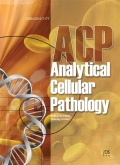Authors: Heideman, D.A.M. | Thunnissen, F.B. | Doeleman, M. | Kramer, D. | Verheul, H.M. | Smit, E.F. | Postmus, P.E. | Meijer, C.J.L.M. | Meijer, G.A. | Snijders, P.J.F.
Article Type:
Research Article
Abstract:
Background: Increasing data from clinical trials support EGFR and K-ras mutation status as predictive markers of tumour response to EGFR-targeted therapies. Consequently, rapid and reliable mutation screening assays are demanded to guide rational use of EGFR-targeted therapies. Methods: In this study, we describe the development of high resolution melting (HRM) technology-based assays with direct sequencing confirmation possibility for mutation screening of the EGFR gene (exons 19, 20 and 21) in routine diagnostic specimens, and compared assay findings to those of conventional nested-PCR following cycle-sequencing. Results: In reconstruction experiments, each HRM assay following sequencing demonstrated a sensitivity of ≤5%
…of mutated DNA in a background of wild-type DNA. The panel of EGFR HRM assays following sequencing applied to a series of genomic DNA samples isolated from 68 FFPE NSCLC specimens correctly identified all EGFR mutations that were previously found by nested-PCR following cycle-sequencing. The HRM approach additionally scored two mutations not detected by the conventional assay. Complementary HRM following sequencing for K-ras revealed three mutations. EGFR and K-ras mutations were mutually exclusive. Conclusions: The panel of designed HRM assays with direct reflex sequencing possibility provides an effective method for mutation screening of EGFR and K-ras genes in routine diagnostic specimens, thereby allowing the selection of the treatment of choice in clinical practice.
Show more
Keywords: HRM, direct cycle sequencing, K-ras, epidermal growth factor receptor, genotype, codon, (nested-) PCR, formalin-fixed paraffin-embedded, molecular diagnostics, TKI, receptor tyrosine kinase inhibitors, anti-EGFR monoclonal antibodies, EGFR-targeted therapies, personalized therapy
DOI: 10.3233/CLO-2009-0489
Citation: Analytical Cellular Pathology,
vol. 31, no. 5, pp. 329-333, 2009
Price: EUR 27.50





